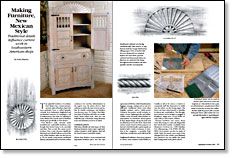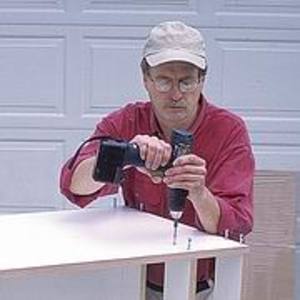Making Furniture, New Mexican Style
Traditional details influence current work in Southwestern American shops
Synopsis: The isolation of northern New Mexico created and preserved a style of furniture that, in its most authentic form, is called Spanish-colonial. This article is about the the history and details of the Rio Grande style of furniture, a sub-type of Spanish-colonial. Sven Hanson talks about common pieces (including their Spanish names) and what makes them unique in this style. He names the tools and materials commonly used to make this furniture, how to carve and finish it, and what influences and trends affected the style. A side article by Andy Charron shows detailing typical of the style.
The splendid isolation of northern New Mexico has created and preserved a style of furniture that, in its most authentic form, is called Spanish colonial. In its Indianized, Anglicized and modernized versions, it’s tempting to call it Southwestern. But what I’m referring to is the distinct Rio Grande style of furniture developed specifically in New Mexico.
New Mexico’s early colonists made beautiful and comfortable furniture, even though they lacked many tools, materials and time. That sounds like many woodworkers’ lives today. Because significant historical and cultural influences are at the root of this furniture style (see the box on p. 70), its sturdy components, traditional joinery and painted and carved decoration continue to be used by cabinetmakers in the region (see the photo above). And craftsmen outside the area borrow and refine its details, techniques and finishes (see the story on p. 72). Today’s New Mexican style of furniture still relies on a traditional hand-crafted look. And you can build this type of furniture using whatever tools and materials you have on hand.
Common pieces
Historians identify six main types of New Mexican furniture: chest (caja), cupboard/ cabinet (trastero), shelf (repisa), chair (silla), bench (banco) and table (mesa).
Chest—New Mexico’s most universal and important furniture piece was the caja (pronounced KA-ha), which functioned as luggage, storage, seating and as sort of a billboard. Traditional chests were often brightly painted and/or relief-carved. Common decorative motifs include rosettes, crosses, lightning bolts and bullets. Visible corner dovetails added further ornamentation. For hardware, chests typically had simple hinges along the back and an offset hasp lock at the front. Chests had various names based on their purpose: an harinero held the family’s grain supply; an hembra held a bride’s trousseau. A variation is the vargueño, a portable desk, which has a trestle base and a fall-front lid.
Cupboard/cabinet—Next most common to chests were trasteros (trah-STAIR-os). Usually as tall as its owner, a trastero is commonly half that dimension in width (see the photo on the facing page). The doors can have raised panels or spindles in almost any combination. The through tenon joinery can be wedged or pegged. A headpiece might have carved shells, always with an odd number of flutes.
Because hardware was scarce, doors were often hung on cotter-pin hinges that had interlocked eyelets (available from Dimestore Cowboys Inc., 4500 Hawkins N.E., Albuquerque, N.M. 87109; 505-345- 3933). Door panels can also be made of metal. Early tin panels were made from salvaged food cans, which were flattened and punched out, not unlike the panel that’s being made in the photo above.
From Fine Woodworking #108
For the full article, download the PDF below:
Fine Woodworking Recommended Products

Drafting Tools

Stanley Powerlock 16-ft. tape measure























Log in or create an account to post a comment.
Sign up Log in